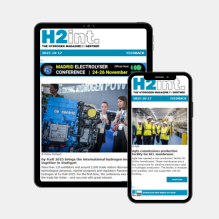A study published on the Nature website in June examined the competitiveness of hydrogen imports from Africa to the EU – with sobering results. Without political backing from European countries, hydrogen from Africa remains too expensive, the study concludes.
The analysis is based on geospatial models used to calculate the levelized cost of hydrogen (LCOH) and evaluates four financing scenarios. According to the study, the lowest production costs for green hydrogen from Africa, exported in the form of ammonia, range between €4.20 and €4.90 per kilogram. Only through government-backed de-risking measures could individual sites reach a competitive level of around €3.20 per kilogram. According to the study, this could be possible in Mauritania by around 2030.
Only 2.1 percent of the sites examined could be competitive under current interest rate conditions with de-risking. However, many of these are located in politically unstable regions such as parts of Western Sahara, central Algeria, or the border area between Sudan and Egypt. In these areas, investment guarantees from international organizations such as the Multilateral Investment Guarantee Agency (MIGA) are scarcely available, further limiting the feasibility of large-scale projects.
Another issue is the mismatch between project size and national economic capacity. For example, the planned Aman hydrogen project in Mauritania requires investments of around USD 40 billion – four times the country’s gross domestic product in 2021. Additional challenges include a shortage of skilled labor for wind energy development, water scarcity in certain regions, and high levels of foreign debt in many African countries.
The Nature authors therefore recommend targeted political support, tied to conditions such as local value creation and industrial use of hydrogen. Countries with existing industrial structures such as Morocco, Egypt, South Africa, or Kenya could benefit more from this than, for example, Namibia or Mauritania.



